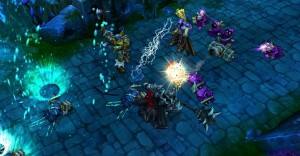The recent release of Order 1886 has been met with damning reviews with one of the major criticisms being its short length. A game’s length is one of the hardest areas to define as too much or too little can impact the experience and there are a lot of factors at work to determine the correct price for game design.
Short but Sweet:
Short titles have really come into their own thanks to the Indie market over the last five or so years. Most indie developers don’t have the funding to create 30+ hour games and instead focus on creating a very refined experience. Now the term “refined” can either be applied to gameplay, story or both.
Gameplay refined titles are games like Binding of Isaac, the titles from Arcen Games and so on where they are going for an unique experience that may not work for 100 hours, but can still be satisfying to play and in some cases, can be later expanded on with expansions. Story refined titles refers to games like Gone Home, The Stanley Parable and others where you’re being pulled into the unique story of the game which may only be a few hours long.
The beauty of designing a short but refined title is that even if the actual gameplay may not have long legs, it can still be enjoyable time after time and someone could play it for a very long time. I spent easily over a hundred hours in the Binding of Isaac just because I was enjoying the game so much and a great game can be something that people would want to come back to in the future and enjoy again.

Short games tend to focus on specific game mechanics or to tell a story and are usually meant to be enjoyed once or twice
Speaking of Isaac, games with rogue-like mechanics are very popular these days thanks to their replayability which can offset the shorten experience.
Good rogue-like design can keep someone coming back for hours on end and in many ways these games can last longer than games built around 80 hours of content.
While short games can be great, some of the most popular and profitable games are those that are meant to be played for a long time.
Going the Distance:
Longer titles can either mean massive experiences like Skyrim, GTA and Final Fantasy or games with a strong multiplayer angle: Call of Duty, League of Legends, World of Warcraft and so on. These are games that are aiming to keep people invested in them for a long time and in the process continue to make money through additional content.
While ten or twenty hours sounds like a long time especially for shorter games, that’s nowhere near enough time spent for someone designing a long title. I know people who have spent years playing World of Warcraft and Call of Duty is designed around almost year round play until the next game in the series comes out.
But long experiences also means big costs and these titles are typically the most expensive to develop and why they arguably earn their $60 price tags. Both long and short games have their advantages and disadvantages but more often than not, the problem that people have with short games is when the price doesn’t match the content.
Price per Hour:
The problem that people have with game length and price is when the cost doesn’t conform to their expectation of the game’s length. The more expensive a game is usually means that there is more value there, however most people equate value to length.
This is why games that are priced cheap yet have a lot of game value to them are looked at favorably among consumers and why the rogue-like genre has taken off so much over the last few years. You can buy a rogue-like for $10-$20 and a great rogue-like can give you close to 100 hours thanks to how unpredictable it is. Case in point is the fact that I spent so much time on the original Binding of Isaac and it only cost me $5.

Long titles are meant to be enjoyed for hours on end either due to a lot of content or continued support by the developers
But the problem is seeing the value of a short game when we’re talking about AAA pricing. A lot of what makes up the triple AAA experience is the aesthetics — powerful graphics engines, quality voice acting, art, etc and all that cost money.
This is also why most AAA games no matter what will have a multiplayer component to them because multiplayer greatly extends a game’s length and can be paired with a short campaign, hence why games like Call of Duty; Gears of War and so on provides both options. You will never see a Call of Duty game developed without multiplayer as the value it brings to a game cannot be understated.
With The Order 1886, while the developers can be commended for creating a unique setting and world, the value was simply not there for a lot of people who were expecting more than just a few hours of play. If there was multiplayer, the game would have been looked at more favorably… but wait, I know what some are you are thinking right now about that statement.
When I talked about Spec Ops the Line, I brought up the fact that the lead developer compared adding multiplayer to a cancerous tumor and was forced by the publisher to do so and hurt the vision of the game. And therein lies one of the problems with AAA development at the moment — It’s very hard to adhere to an artistic vision and not a financial one.
If you look at every other third person shooter released over the last decade, just about every one (or the most popular) had some kind of multiplayer mode because again publishers know the value they bring. Publishers want the most amount of money earned when they are spending millions on developing a game and why many of them demand multiplayer of some sort put in.
As we talked about at the start, making a short game can be great as it lets the developer create a refined experience, but the challenge is figuring out how to sell that to consumers.
Dollars per Hour:
Video game pricing is one of the hardest things to get right about your game and in many ways can make or break your game on the market. Obviously you as the developer want to get as much money as possible for your time and energy put into making the game, but you can’t sell a game that is only meant to be played for three hours for sixty dollars.

DLC and continued support has become a popular way to get more profit out of a game and add value to it at the same time
And this is why so many AAA titles have trouble getting their premium price as the additional costs that demand that high price tag don’t translate into game content that benefits the consumer.
Incidentally, this is another advantage of AA and Indie development as they can sell games cheaper by cutting areas like expensive engines and voice acting to lower their game price and still make back the development cost.
One of my more out there post ideas I’ve been thinking about is literally a check list of all the elements that add value to a game and ergo should raise the price tag and maybe I will write that at some point.
Unfortunately for AAA developers, consumers these days are able to get a lot of value from the Indie market at more than half the price and the sheer volume of games means that most people don’t have to spend $60 to get the newest titles. This leaves AAA development with two options: Either figure out a way to reduce the cost of development and lower the MSRP for their titles, or raise the value of their games somehow with more content like DLC or multiplayer to make up the profit.
This is another one of those conversations that we can’t answer in just one post. With the continuing debate over mobile and social game value throwing a monkey wrench into the mix and even early access, there is sure to be a shakeup in game value coming by the end of the decade.


